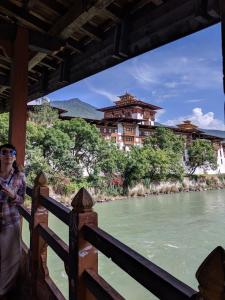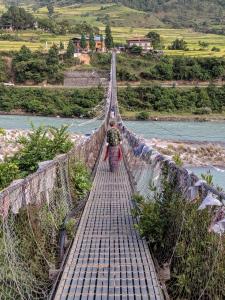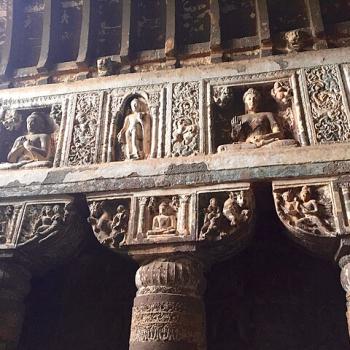Our Bhutan adventure continues.
We spent part of the day once again taking in the continuing sacred dances, Tschechu, just outside of Punakha. Sadly, this time the governor didn’t come out and greet us, put us in the expensive seats, and ply us with salty butte tea. It was a much bigger crowd, although not of the crushing variety we experienced in Thimphu.
There is something more than pre-modern, I think the word ancient is right about these dances. Especially how languid the approach, how slow it all is. It was an invitation to a time before time ruled the day. And, of course, if we are in danger of slipping into some maudlin revery, there are always the Atsaras to mock and invite.

Frankly, I’m past wary of “crazy wisdom.” I think it can be argued such figures in the West standing in that path often did at least as much harm as good. And I’m leaning toward more. But, as a current within something larger, as with the astaras, not the main show, but making sure the principal currents don’t think they’re it, either: then magic happens. Or, at least, can…
From the dances we made our way to a traditional Bhutanese restaurant. I was a tad suspicious that there were compromises for foreigners. Still, it was fun. Turns out I like the “national dish,” ema datshi. I’d had it first at the hotel. The staff warned it might be too spicy. It wasn’t. This time it was served as part of a lunch buffet and while a tad spicier than at the hotel, it was totally within reasonableness. 
At least I thought so. But as I’m getting older I’m discovering my tastebuds are getting a bit duller and so more bite is generally a good thing. Okay, at least as long as the stomach doesn’t decide it wants mild. Which would be a disappointment. Of course among the disappointments of life, not particularly close to the top of that list…
Between the road and the restaurant were several tourist shops featuring the human phallus. While in my very limited experience not quite the ubiquitous Bhutanese ornament I’d read about our encountering, they certainly are here and there. Most notable to me painted on the sides of some buildings. I have a feel, generally more rural buildings.

From there we proceeded to the historic Palace of Great Bliss, the Punakha Dzong, a (mostly) convert fort, situated at the confluence of the Mo Chhu (Mother) and Pho Chhu (Father) rivers, which flowing together to become the Sankosh River.
There are several legends about the Dzong and its founding. The earliest fort appears to date from 1638, and built by Ngawang Namgyal, the Tibetan lama who would unify the Bhutanese people and help clarify them as a separate culture from Tibet. His body is interred in the Dzong.

It has been expanded over the many years. Today its the second oldest dzong in the kingdom, and considered the most magnificent of Bhutan’s historic buildings. Its roof was a gift from the 7th Dalai Lama. The Dzong has suffered the assaults of time, storms, fires, and earthquakes, and most recently in 1986was partially destroyed by fire. The source of that fire has not been determined, although it is widely believed to have been the result of an accident with a butter lamp. This allowed a reconstruction that included adding a large prayer hall.
I found the whole thing breath taking.

I was especially moved by the Buddha hall with its lovely murals depicting the life of the Buddha as well as astonishing status of the Buddha sitting, and flanked by nearly as large statues of Guru Rinpoche and Zhabdrung dating from the mid 18th century. They were each draped in cloth Kasaya (O-kesa to me). They looked to be designed in the Chinese style, but as I had wandered from my group at the time I was unable to ask.

It felt like the history of independent Bhutan, always independent, never colonized, although with a couple of near misses, all are baked into the walls of this place. I felt honored to walk through the courtyards and witness the grandeur of this small and fiercely independent Himalayan kingdom.
Then, as frosting on the cake, and our last exploration of the day, we walked out to the Punakha Suspension Bridge, the largest in the kingdom. Nearly six hundred feet long it is dropped, as bridges are in the country, with prayer flags.

Standing at one end and contemplating the distance as well as the Po Chhu river, I felt once again the invitation that has been constantly presented on this trip.
In the Blue Cliff Record, case 52, we’re given a little story.
A student of the way went to Zhaozhou and said, “The stone bridge of the master is known throughout the world, but coming here all I see are some stepping stones.” The master replied “You only see stepping stones and do not see the full bridge.” The student asked, “What is the full bridge?” Zhaozhou replied, “It lets donkeys cross. It lets horses cross.”
Or, as Rumi sang to us, wander, worshiper, lover of leaving. Come, come. Whoever you are. Come…
Step out.
Step out onto the bridge.
Wonders Await…













